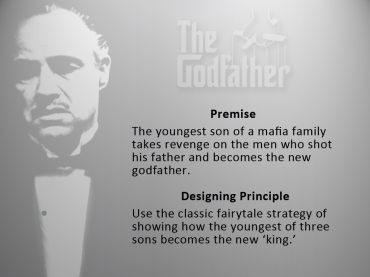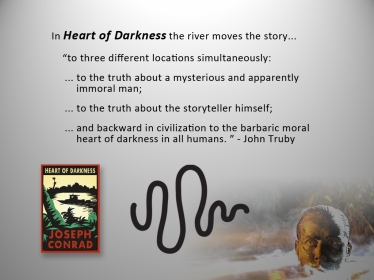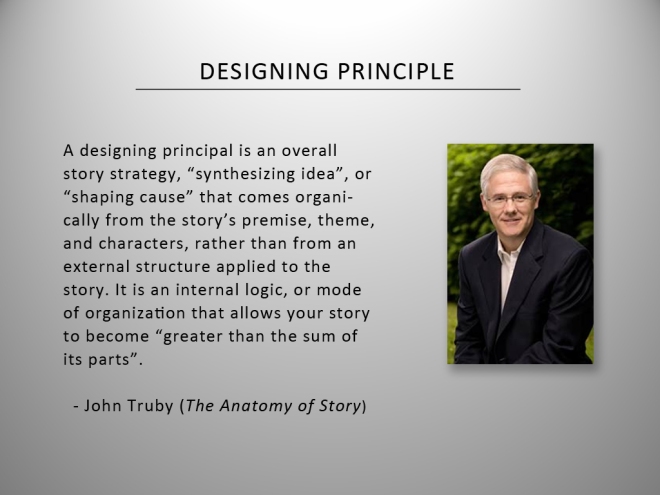I’m my previous posts I’ve given you a pandora’s box of alternative plots (Alt. Plots Part 1 and Alt. Plots Part 2) as well as alternative structures (Alt. Structures Part 1 and Alt. Structures Part 2). And we ought to take classic design, the hero’s journey, and three act structure and throw them in that box as well.
But how do we use these?
How do we incorporate them into our writing process in a way that is organic? How do we make sure they come naturally from the story itself without becoming a dead-in-the-water template?
John Truby suggests that the best way to do this not through an external structure, but to look inside the work for an inherent designing principal. Truby is a little abstract in his definition of a designing principal, so here’s my cobbled-together version from what he says in the Anatomy of Story:
Does that sound like a bunch of writerly-MFA-mumbo jumbo? Let me give you some examples to help us understand the concept.
In the film The Godfather, the premise is: The youngest son of a Mafia family takes revenge on the men who shot his father and becomes the new Godfather. The idea of a designing principal is to find something that derives from that premise and those characters which adds a new layer of meaning, giving the story its originality, and acts as a guide for the writing process.
 According to Truby, the designing principal of The Godfather is: “Use the classic fairy tale strategy of showing how the youngest of three sons becomes the new ‘king.’” With this underlying design the story is no longer generically about the mafia or revenge. Through the use of a fairy tale trope the story becomes elevated to one of legend. The fairy tale offers the writer a basic scaffolding for plot structure and there’s opportunity for thematic comparisons between the original story and its re-telling.
According to Truby, the designing principal of The Godfather is: “Use the classic fairy tale strategy of showing how the youngest of three sons becomes the new ‘king.’” With this underlying design the story is no longer generically about the mafia or revenge. Through the use of a fairy tale trope the story becomes elevated to one of legend. The fairy tale offers the writer a basic scaffolding for plot structure and there’s opportunity for thematic comparisons between the original story and its re-telling.
Another example is the use of a traveling metaphor such as a river. In Heart of Darkness, the protagonist, Marlow, is taking a boat ride up the river and progressing deeper and deeper into the jungle. The river is a designing principle for both structure and metaphor, moving the story into “three different locations simultaneously: to the truth about a mysterious and apparently immoral man” who Marlow is going up the river to find, providing plot structure for the external story. “To the truth about the storyteller himself;” a metaphor for the internal emotional story as the protagonist goes deeper into his own psyche. And it moves us “backward in civilization to the barbaric moral heart of darkness in all humans,” the novel’s underlying theme. The traveling metaphor contains the external story, the internal story, and the theme. No wonder this book is a classic.
 There is no one way to create a designing principal, there are hundreds of them, and the one that is right for your story only you can find. But I’ve noticed certain “categories” if you will, certain patterns that designing principals sometimes fall under. The execution of each is unique to the themes and characters of each book, but I want to present the list I’ve generated thus far, as a jumping off point. My goal is to further illustrate this concept and to help you think about what might be the designing principal of your book.
There is no one way to create a designing principal, there are hundreds of them, and the one that is right for your story only you can find. But I’ve noticed certain “categories” if you will, certain patterns that designing principals sometimes fall under. The execution of each is unique to the themes and characters of each book, but I want to present the list I’ve generated thus far, as a jumping off point. My goal is to further illustrate this concept and to help you think about what might be the designing principal of your book.
I have six categories that I will discuss in my next posts:
1. A Character’s Mental State
2. Setting and Environment
3. Time
3. Community
4. Fairy Tales, Myth and Parallel Stories
6. Storyteller
Read more about John Truby’s concept of a designing principal on pages 25-29 of The Anatomy of Story.


I’m looking forward to your future posts about the six categories. Thanks!
Wow. I saw The Godfather and never thought about the fairy tale aspect. Very intriguing! Makes the story so much richer.
This is a brilliant blog, many thanks!
Thanks, Cecilia. I’m glad you’re enjoying it!
I don’t even know how I ended up here, but I thought this post
was great. I don’t know who you are but certainly you’re going to a famous blogger if
you aren’t already 😉 Cheers!
I have been reading the anatomy of story over and over again and testing its ideas in my writing but like you said, he is a bit abstract about the designing principle and you have helped me a lot. My troubles are partially because I’m not a native English speaker and the book has not been translated to my language but I understand a lot more thanks to your post. I would probably figure out more if I knew these things for Lord of the Rings (designing principle, theme line and symbol line particularly) Truby does tell about it but so little and so widely and though everybody gets some idea of what Tolkien has been doing there I have no idea what the designing principle is.